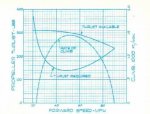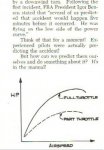- Joined
- Oct 30, 2003
- Messages
- 18,374
- Location
- Santa Maria, California
- Aircraft
- Givens Predator
- Total Flight Time
- 2600+ in rotorcraft
Philbennett;n1142104 said:and how is any of that relevant to the graph which has a curve labelled "engine power available at full throttle" verse airspeed? If one puts full throttle at zero airspeed is engine power not available?
In my opinion the engine graph showing horsepower at rpm is not relevant to describing flying behind the power curve.
My Lycoming IO-320 will make 140 horsepower at 2,300 rpm if I lift off at 20kts and because I am flying behind the power curve my climb out will be less than 200 feet per minute. If I lift off at 45kts I will still be making a little over 140 horsepower and yet I will be climbing in the range of 1,100 feet per minute.
I refer to that as flying behind the power curve not because I am lazy but because that is the correct term according to the FAA and the physics.
The people I am trying to communicate with share the definition of behind the power curve.
Flying behind the power curve is unrelated to the engine's power curve.
You graph appears to me to be horsepower at rpm rather than horsepower at airspeed.




